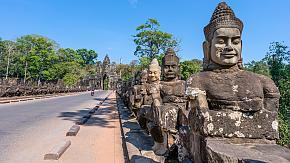Cuisine from the Cambodian Kitchen
Over the years, the cuisines of Thailand and Vietnam have worked their way across the world and, quite deservedly become well-known. When I left the UK 25 years ago, there were only a few Thai restaurants and I'm reasonably sure none which were Vietnamese, but when I visited this summer, they were everywhere and even totally English pubs were offering Thai or Vietnamese dishes on their menus.
But what was once called Indochina wasn't just those two countries. Laos has a wonderful cuisine, too, but you may know it without knowing you know it. Many northern Thai dishes are actually from Laos. Yet, one cuisine from the area remains largely unknown - Cambodian or Khmer Cuisine (សិល្បៈខាងធ្វើម្ហូបខ្មែរ). I'm told that London, despite having a huge range of international cuisines on offer, still only has one Cambodian restaurant.
Like most of the countries in this part of the world, Cambodia has taken culinary influences from its immediate neighbors, Thailand, Vietnam and Laos, as well as further afield. China has had a great impact on the Cambodian menu and France has left its legacy from colonial times. Of the outside influences, China and Vietnam have been the most powerful. However, all of these influences have been blended into a distinct Khmer style of cuisine, with domestic touches and traditions.
Before we begin to explore the cuisine, a word about etiquette. Like the Thai people, Cambodians normally use a spoon and fork to eat, unless having soup, when it's a spoon and chopsticks. The fork is used to push food by the left hand onto the spoon, which is held in the right. Putting the fork to your mouth is considered to be bad mannered - eat from the spoon.
I'll start with some of the more unusual ingredients that are used. Unsurprisingly, the cuisine uses many of the same ingredients as its neighbors - fish sauce, lemongrass, kaffir lime peel and leaves, galangal, turmeric, tamarind etc. From China there is soy sauce, oyster sauce and Hoisin sauce. But there are a few specifically Cambodian ingredients which you are sure to encounter on your trip. Fermented pastes and sauces are a big feature of the cuisine.
 Dried Cambodian herbs and spices
Dried Cambodian herbs and spices
Prahok (ប្រហុក) is a very common ingredient and turns up at almost every meal. It is a strong tasting, salty paste made from fermented fish (usually snakehead fish), and is used either in dishes or as a dipping sauce on the side. Many travelers report that it is somewhat of an acquired taste, but once acquired none want to miss it.
Kapǐ (កាពិ) is a strong fermented shrimp paste which turns up in most dishes which don't use prahok!
Kroeung (គ្រឿង) is another paste, this time consisting of herbs and spices, most commonly dried red chilies, garlic, lemongrass, kaffir lime zest and leaves, galangal, lesser galangal, turmeric, and shallots. Depending on the dish to be cooked, the proportions of each herb or spice in the paste is altered to suit. In fact, the same kroeung may never be made twice to exactly the same recipe! It also varies in color from red to green to yellow depending on the mix of herbs.
Kampot (ខេត្តកំពត) province in the south-west corner of the country, along with its neighboring province, Kep (កែប) is noted for its pepper. Cambodian cuisine makes less use of chili peppers than its neighbors, preferring to use black pepper. Kampot pepper (ម្រេចកំពត) is world famous and revered by all the planet's top chefs and gourmets, who consider it to be the world's best.
The first mention of Kampot pepper was in the memoirs of Chinese explorer Zhou Daguan who visited in the 13th century. Production really began in earnest when the French delighted in the pepper and brought in more sophisticated growing techniques. It was carried to France and right up until the 1970s if you ordered steak au poivre in a top French restaurant you would be served Kampot pepper. Production stopped completely during Pol Pot's genocidal regime between 1975 and 1979 and most of the pepper vines were destroyed. Production resumed in the year 2000, but moves at a slow pace. The rarity of the pepper means that prices are high, but production is rising. The 2019 harvest is expected to reach 90 tons, up from last year's 73. Compare this to the nearly 9,000 tons produced pre-Khmer Rouge!
Protected by law with Geographical Indication protection (GI) awarded in 2010, the name Kampot pepper can only legally be used for pepper grown under strict conditions in Kampot and Kep. It must be grown without the use of artificial fertilizers or chemical pesticides, so is an organic product.
Although the black variety is best-known and most easily available, there are, in fact, four colors of Kampot pepper. Green pepper, the immature peppercorns, are used locally, but deteriorate in quality very rapidly, so are rarely found outside the region. Kep crab with green Kampot pepper (ក្តាមម្រេចកំពត) is a must-try if you are in the area. The black peppercorns are green peppercorns which have been dried in the sun for two to three days. This process turns them black. The black pepper tastes simultaneously strong, yet mild. It is seldom used while cooking dishes, instead being freshly ground over the dish at the table.
Left to ripen on the vine, the peppercorns turn from green to yellow then finally to red. Fruity and less spicy than the black, the red pepper is the most prized. It works well with both savory dishes and with desserts. Try it freshly ground over strawberries for a real treat! Finally the red peppercorns can be soaked overnight and the skin stripped away leaving white pepper which is then re-dried before being sold. This white pepper is the spiciest, but is also herbal and has notes of lemon in the taste. The red and white are difficult to produce as they have to be harvested by hand at exactly the right time. This labor intensive production makes them both rare and costly.
It is possible to visit several of the pepper farms and learn about the production processes. Sothy's Pepper Farm and La Plantation are two that come recommended. Both offer free guided tours in several languages (English, French, German, Spanish, Japanese and Khmer at Sothy's and English, French and Khmer at La Plantation). La Plantation has two very good restaurants and also offers Cambodian cooking classes. If you wish to buy pepper to take home, buy it from one of these farm shops to guarantee the quality. Markets elsewhere usually pass off cheap, low quality pepper from Vietnam and other places which use chemical fertilizers and insecticides, pretending they are the real thing and charging accordingly. Caveat emptor!
The range of fruit (ផ្លែឈើ) in Cambodia is truly astonishing. Durian is considered to be the King of Fruits who presides with his Queen, Mangosteen.
 Mangosteens (មង្ឃុត)
Mangosteens (មង្ឃុត)
Other fruits include various types of banana, kumquat, guava, rambutan, water melon, papaya, dragon fruit and many, many more. Most are eaten as dessert or table fruits, but some like mango and pineapple are incorporated into savory dishes such as salted fish dishes served with rice.
Vegetables (បន្លែ) show a distinct similarity to Chinese vegetables - bitter melon, lotus root, bok choy, eggplant, bean sprouts etc are all available. The favourite however is water spinach. Vegetables are usually stir fried in the Chinese manner.
By far the most important meat consumed in Cambodia is fish (ស្ទូចត្រី). Being the second wettest country in Asia (after Bangladesh), fresh water fish from the Mekong River and Tongle Sap Lake makes up around 60% of the protein consumed. Perhaps Cambodia's best known dish is fish amok (អាម៉ុកត្រី), which is usually filleted catfish from the Mekong, cooked with kroeung, roasted crushed peanuts, coconut milk, and egg. It is often served wrapped in banana leaf or with rice in restaurants.
 Fish amok (អាម៉ុកត្រី) with Cambodian jasmine rice
Fish amok (អាម៉ុកត្រី) with Cambodian jasmine rice
Other forms of seafood such as shrimp, squid, crayfish etc are popular choices and other meats consumed include pork and chicken. Snails (ខ្យង) are common, often grilled with garlic butter, something they obviously learned from the French. More unusual meats include crocodile, frogs, and various insects and spiders, including tarantulas.
 French style grilled snails in Cambodia
French style grilled snails in Cambodia
Soups (ស្ញុប) are common, too, especially soup stews known as samlar machu (សម្លម្ជូរ), which are eaten with rice. One type, samlar kakou (សម្លកកូរ), is so popular it considered as one of Cambodia's national dishes. It usually consists of fish, pork or chicken and vegetables, flavored with kroeung and fish paste, but there is also a vegetarian version which uses vegetable stock and coconut cream.
Nham nguv (ស្ងោរមាន់ង៉ាំង៉ូវ) is a chicken soup with one ingredient not usually found among Cambodia's neighbors. This is preserved lemon which may have been introduced by Hakka or Zhuang Chinese who both use it as an ingredient.
Noodle soup dishes, introduced from China, are plentiful here. Kuy teav (គុយទាវ) are very popular flat rice noodles served in a pork broth with aromatic herbs served with numerous garnishes such as lettuce, bean sprouts, spring onions (scallions), sawtooth coriander and holy basil), crushed black Kampot pepper, lime juice, and caramelized garlic oil. Chilies, chili sauce, soy sauce and/or fish sauce can also be added. The capital, Phnom Penh is well known for their special version of kuy teav, which is more luxurious, featuring such additions as pork belly, ground pork, congealed pig's blood, chopped pork offal, roast duck, Mekong river prawns, or squid. Available everywhere, kuy teav is normally eaten for breakfast.
Chinese style stir-fries (ឆា) and fried noodles are also common. Fried kuy teav noodles are popular in the southern regions, Bai Chha (បាយឆា) is fried rice with Chinese sausage, garlic, soy sauce, and herbs and is often eaten with pork. Mee Kantang (មីកាតាំង) literally means 'Cantonese rice noodles' and is stir-fried noodles with oyster sauce, vegetables and usually, beef. Another interesting noodle dish is Mee Kola (មីកុឡា). No, it isn't noodles cooked with Coca Cola! It is a specialty of the Kola ethnic minority and is stir fried rice noodles seasoned with oyster sauce and served with nuts, vegetables and fish sauce.
Many of these stir-fry dishes are sold as street food along with other temptations. The French left behind baguettes which are sold here in various sandwiches including a Cambodian version of Vietnam's bánh mì. A firm favorite is deep fried bread cakes with shrimp.
 Deep fried bread and shrimp cakes (ប្រហិតបង្គាបំពង)
Deep fried bread and shrimp cakes (ប្រហិតបង្គាបំពង)
Well, you are probably thirsty by now so what is there to drink. Mineral or purified water (ទឹកបរិសុទ្ធ)is available. It is not advisable to drink tap water. Beer (ប៊ីយេរ)is cheap and fine. Angkor Bia is the most famous brand. Angkor rice wine (ស្រាអង្ករ), made in Siem Reap is used at festivals, weddings and other celebrations. Coffee (កាហ្វេ), especially strong Iced Coffee កាហ្វេទឹកកក. Coffee can be served black or white, which is made with condensed milk and is quite sweet and thick.
Cambodian cookery classes are available in all the major tourist destinations and most offer the opportunity to visit a local market to buy the necessary ingredients, then return to the kitchen to learn how to turn them into an authentic Cambodian meal, which you can then enjoy.
Odynovo cantailor make you a tour of Cambodia, include any or all of the most amazing attractions such as Angkor Wat, as well as bringing you an unusual eating experience. Just tell us your dreams and wishes for a perfect trip and we'll get back to you in 24 hours with your personalized, no-obligation itinerary.
Quick Question
What Our Clients Say
Explore the latest verified reviews of Odynovo's travel services on Tripadvisor, Google, Trustpilot, Product Review and more trusted platforms.









